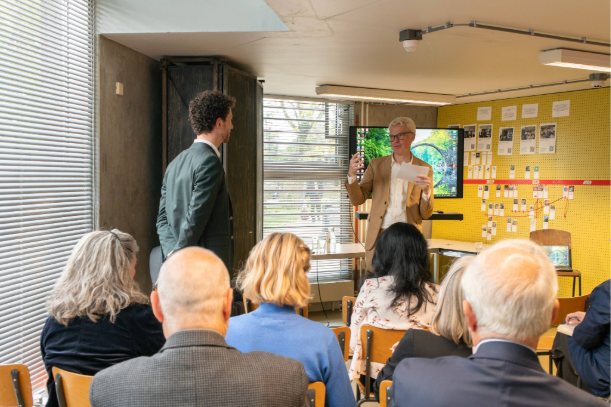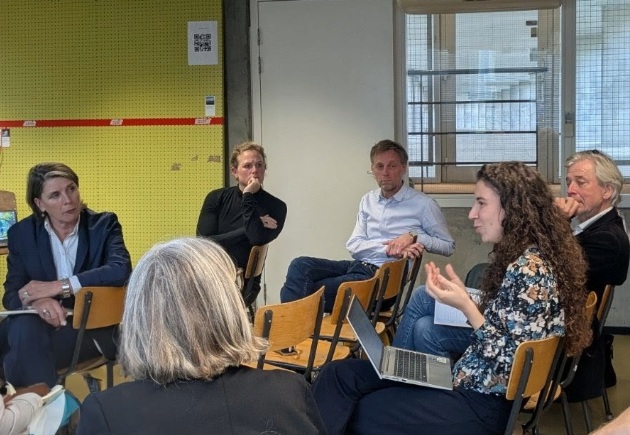The Housing Dilemma: A Roundtable Discussion
On 20 October, we welcomed IFHP members and the wider community to a public roundtable titled “The Housing Dilemma: Affordability Now vs. Resilience Tomorrow”, co-hosted by IFHP and Vereniging Deltametropool at the Toekomstatelier Oostkop, Nieuwe Instituut, Rotterdam. The session brought together a diverse group of housing experts, policymakers, academics, and practitioners from across Europe to explore a pressing question: how can we accelerate the production of affordable housing while safeguarding ecological and social resilience?
This Roundtable brought together a diverse group of participants, including representatives from the municipalities of Utrecht (Kees Verschoor), The Hague (Sarah Rach), and Amsterdam (Henriette Rombouts), and Ministry of Housing and Spatial Planning (Geert Slabbekoorn). They were joined by architect Willemijn van Manen (ZUS Architects) and Professor Marja Elsinga (TU Delft). From the IFHP community, former board members Gary Klassen, Klaus-Peter Hillebrand, and Regitze Marianne Hess participated, alongside current board members Esther Agricola, Erik Pasveer, and Maurits Schaafsma and newly appointed director of operations Alankrita Sarkar.
Participants discussed the affordability and resilience of housing and how they must no longer be seen as competing goals. Instead, the real challenge lies in aligning immediate needs with the structural transformations required for a sustainable future. As several speakers noted, this involves strengthening the connection between bottom-up initiatives and increased transparency and collaboration at every level. Cities must rethink land ownership and financial models and design innovations for flexible, long-term housing concepts. Local experiments and community efforts are key here. Inclusive decision-making is part of this too, ensuring homeseekers’ voices are heard. Participants also stressed the importance of regional cooperation within the wider metropolitan housing market, acknowledging that solutions extend beyond city borders.
The roundtable’s reflections will be integrated into the final sessions of the IFHP x VDM Learning Lab series, which continues later this year. This discussion set a clear direction for IFHP’s renewed agenda: reconnecting planning practice with social and environmental values, and facilitating knowledge exchange between scales, actors, and regions.
Statements
The afternoon began with introductions by Paul Gerretsen and Alankrita Sarkar of the theme “Affordability Now vs Resilience Tomorrow”. Then the Rotterdam case study Atelier Bloemhof was pitched, after which four speakers presented statement pitches exploring housing and resilience practices. This was followed by a group discussion.
Willemijn van Manen introduced Atelier Bloemhof as a bottom-up initiative aimed at preserving and revitalizing a neighborhood in Rotterdam. Bloemhof faces complex challenges: water management due to low-lying soil, subsidence and black mold, narrow streets with little room for extra water storage, and fragmented ownership structures. These issues are compounded by a lack of clear responsibility between private owners, housing cooperatives, and the municipality.
Two parallel tracks are currently in motion:
— Atelier Bloemhof (bottom-up): Engaging directly with the community to explore soil conditions and neighborhood needs, though currently paused by the municipality.
— TU Delft (top-down): Developing scenario studies to guide spatial transformation.
One of the key proposals, the “Natte T” scenario, envisions a block-by-block transformation—creating more space for water and gradual, ethical redevelopment that protects the community fabric, in contrast to large-scale clearance projects like Tweebosbuurt, which suffered from poor communication and resident distrust.
Geert Slabbekoorn presented the perspective of the Ministry of Housing and Spatial Planning. He identified the tension in the interaction between subsidies and investments. The shift from construction subsidies to subject subsidies (income-based housing support) over the past century has blurred the line between social policy and housing policy. Housing corporations are now expected not only to address shortages but also to invest heavily in climate resilience, renovation, and new construction, all within tight financial constraints. Subject subsidies help pay the rent but are also indirect tool for housing investors.
Second, Sarah Rach outlined The Hague’s housing dilemma, shaped by demographic change, ageing, and individualization, which strain social cohesion and housing supply. The housing market has stagnated: people aren’t moving, and new homes are often too small for families. The city also faces physical space constraints, balancing demands for housing, green areas, energy transition, and economic development. She stressed the need to think beyond short-term crisis management and adopt a long-term, integrated approach to housing, combining social and spatial strategies. New concepts like cohousing and shared living could help but remain politically sensitive.
Kees Verschoor presented Utrecht’s housing challenge as a trilemma: balancing quantity, quality, and affordability. Affordability is not a general issue. It hits young people and renters the hardest, especially in cities, while homeowners and residents in provincial areas are less affected. He emphasized that the sector must confront its own limitations: current business models fail to deliver sufficient social and mid-range housing, even though these groups make up most of the population. Despite high land values and limited construction capacity, the importance of collective responsibility and collaboration across sectors to find solutions must be stressed. When asked what residents value most, the answer was simple: a roof over one’s head. Meeting that basic need must come before anything else.
Finally, Erik Pasveer discussed Amsterdam’s financial and spatial housing challenges, noting that many constraints are driven by microeconomic forces, including speculative and sometimes opaque capital flows, beyond direct municipal control. While not all issues can be solved locally, the city must still take action where it can. Business cases for housing remain complex but feasible, with Amsterdam needing to build around 7,000 homes per year to keep pace—though actual demand is far higher. The city faces continued population influx, functioning as a “migration hotel,” which strains affordability and capacity. In Amsterdam, urban development is not only about quantity, but also about revitalizing post-war neighborhoods, fostering new partnerships with housing associations, and reimagining urban form as a tool to bring people together.
VDM and IFHP
VDM and IFHP share a common vision, focusing on urban and societal development with a high quality of life as their primary objective. Collaborating on this agenda brings together both the local context and global perspectives to tackle challenges with sustainable and socially equitable spatial development, planning and housing. While VDM focuses on the Eurodelta and IFHP represents the broader international context. This collaboration led to the establishment of a formal partnership with a Memorandum of Understanding to develop a shared vision and action plan from 2024 onwards.






